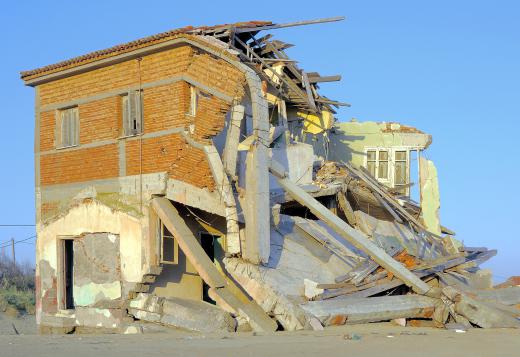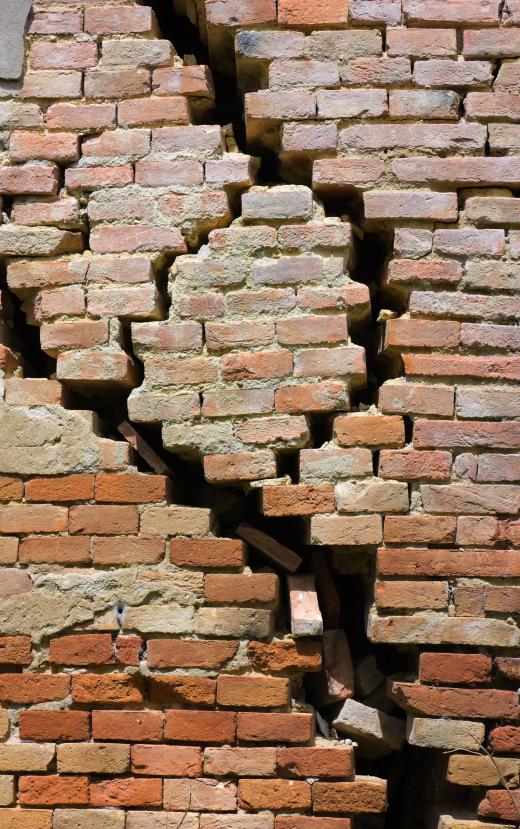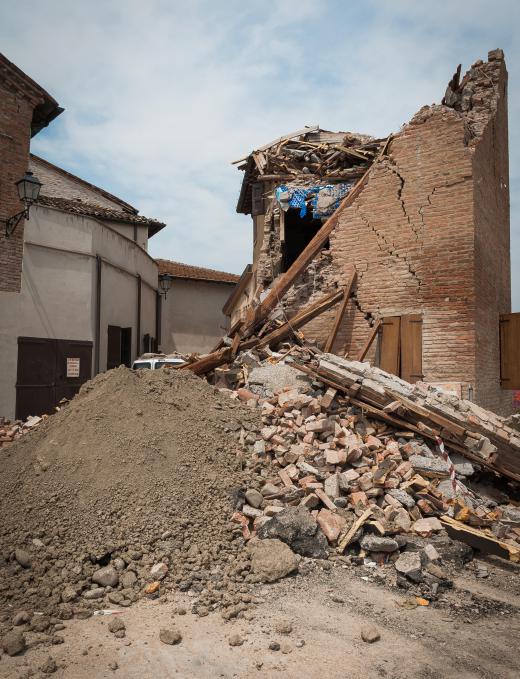What is an Aftershock?
 Tricia Christensen
Tricia Christensen
When an earthquake hits it might fall into three different classifications. Some earthquakes are foreshocks and are usually smaller earthquakes occurring in about the same area as a larger quake will occur later. Others are the big event or a mainshock, which will be the earthquake of largest magnitude that occurs. After this large earthquake others may follow that are smaller, but still can be dangerous, and these are called aftershocks.
A more specific definition of aftershock is that it is seismic activity representing the earth’s readjustment along a fault line after a mainshock event. Such earthquakes will happen near the mainshock, as do foreshocks, and could occur for some time after a mainshock event. Usually greatest danger of another earthquake with a relatively high magnitude as compared to the mainshock is during the first few days. This danger can exist for several reasons.

With a large main earthquake, especially in a well-populated area, structural damage can occur to many different things. A high magnitude aftershock could pose a considerable risk because it might complete the structural damage of certain things. It could cause buildings to collapse, gas lines to break, or other serious problems. It greatly raises the chance of more people losing property or becoming injured. The combined effect of a large mainshock and an only slightly smaller aftershock is sometimes devastating.

One thing that can confuse people is when an aftershock has a higher magnitude rating than a mainshock. When this is the case, the whole set of earthquakes plaguing an area has to be reclassified. Suddenly the aftershock is not “after” any more and becomes the mainshock. The mainshock gets shifted into foreshock status. It may take a while to look at a series of earthquakes and determine which one was central, and which were fore and aftershocks.

It’s often been noted that recovery from shocks of any kind takes time. This is especially true of aftershocks, which can continue to occur many years after a mainshock happened. Recently it’s been suggested that the distance of an earthquake from tectonic plates may govern the way land reacts afterwards. If an earthquake was far away from tectonic plates, the amount of recovery time from it, could take much longer. For instance, some earthquakes occurring in the US Midwest today are thought to be aftershocks of ones that occurred in the early 19th century. The earth appears to have a long memory in this theory.
For people who have just encountered a larger earthquake, the possibility of experiencing an aftershock should be considered. If a dwelling is unsafe, it ought to be exited until cleared, or if a few things appear to be in disarray, cleaning these quickly is advised. Such times can be difficult to endure and are made more frightening by the potential for additional earthquakes. Just as the land recovers through these continued tremblers, many people may find themselves desiring recovery time too; aftershocks may be both emotional metaphor and physical expression of the earth.
AS FEATURED ON:
AS FEATURED ON:













Discussion Comments
Actually I read that scientists can know how many aftershocks to expect after a main earthquake. They use something called Omori's Law. This law says that aftershocks will have less intensity than the mainshock. So the bigger the mainshock, the more aftershocks there will be. There is a formula for this law. They can look at the data from the main earthquake and estimate for how many years there will be aftershocks.
I think this is how they know that an earthquake that happens decades after another one is actually an aftershock of that one and not a new earthquake.
@ysmina-- I had to read some articles on earthquakes for class. What I got from these articles and class discussions is that earthquakes are categorized by using common sense, not really based on a formula or a specific magnitude. It's as simple as figuring out which earthquake has the highest magnitude within a time frame. And then labeling the ones before this earthquake as foreshocks and ones after as aftershocks.
I don't think that there are any other differences between these earthquakes other than their magnitude.
Wow! I didn't know that scientists have to compare the different earthquakes to know which is the foreshock, the mainshock and aftershock. That means that when an earthquake happens, we should take precaution because a bigger one might be on the way.
I also have a question about labeling. When I watch news about earthquakes on TV, I always see it labeled with a number like 6.7 or 5.2. I think this is the intensity of the earthquake right? Is there a range for aftershocks that helps scientists categorize them? Like if an earthquake falls between certain intensities, it is most likely an aftershock or a mainshock?
thanks for this information i really needed help on my research project and you just made it a whole lot easier for me. this information seems really accurate and i will be sure to tell my friends about this site for when they have to do it. thanks again. p.s. this site is also really cool and not boring. :)
Post your comments